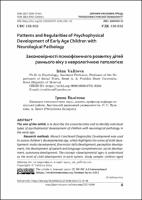Показать сокращенную информацию
Patterns and Regularities of Psychophysical Development of Early Age Children with Neurological Pathology
| dc.contributor.author | Валитова, Ирина Евгеньевна | |
| dc.date.accessioned | 2021-12-07T08:22:21Z | |
| dc.date.available | 2021-12-07T08:22:21Z | |
| dc.date.issued | 2021 | |
| dc.identifier.citation | Valitova, I. Patterns and Regularities of Psychophysical Development of Early Age Children with Neurological Pathology / I. Valitova // Problems of Modern Psychology : Collection of Research Papers. – 2021. – I. 52. – РР. 9–39. | ru_RU |
| dc.identifier.uri | https://rep.brsu.by:443/handle/123456789/7348 | |
| dc.description.abstract | The aim of the article: To describe the characteristics and to identify individual types of psychophysical development of children with neurological pathology in the early age. Research methods: Munich Functional Diagnostics Development was used to assess children's developmental age, which highlights the areas of child development: motor development, fine motor skills development, perception development, the development of speech and language comprehension, social development, autonomy development. The concept "developmental age " is understood as the level of child development in each sphere. Study sample: children aged one to three years with neurological diagnoses of cerebral palsy (n=99) and CNS PROP (n=201). Results of the study. The indicators of developmental age in all spheres increase with the increase of child chronological age, which indicates the dynamics of psychophysical development in the period from one to three years. The value of the indicator of the discrepancy between the chronological age and the age of development increases by children of the third year of life compared to the children of the second year of life, which means that development speed of children slows down. Based on a set of criteria six types of child development profiles which are presented in the general sample with different frequency, were identified: the most common profiles are those with a significant decrease in the developmental indicators, less often – profiles with a slight decrease in the developmental indicators and the profile with an excess of chronological age indicators is found in rare cases. The types of development profiles are not strictly related to nosological categories. Conclusions. The developmental profile reflects the structure of the defect, and allows to define backward and intact function as well as to set objectives for remedial work and to determine the zone of proximal development of the child. The established patterns of development of a child with a neurological pathology will be of interest to neurologists and also have practical significance for dealing with mothers, who have no idea about the slowing down of the child's development with age. | ru_RU |
| dc.language.iso | ru | ru_RU |
| dc.subject | early age, psychophysical development, developmental disorders by children, neurological pathology, cerebral palsy, organic lesions of the central nervous system, patterns of developmental disorders, developmental profile | ru_RU |
| dc.title | Patterns and Regularities of Psychophysical Development of Early Age Children with Neurological Pathology | ru_RU |
| dc.type | Article | ru_RU |
